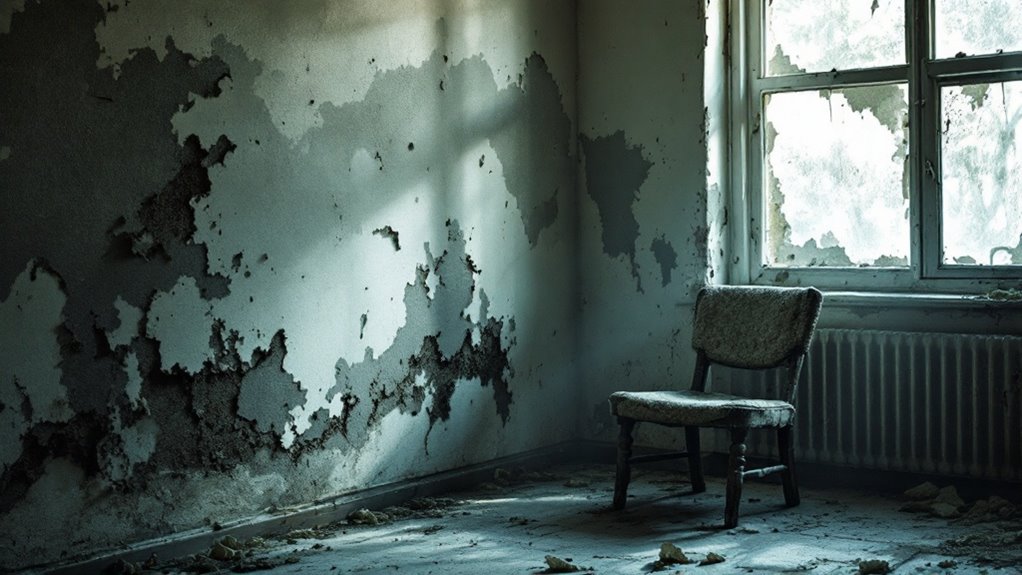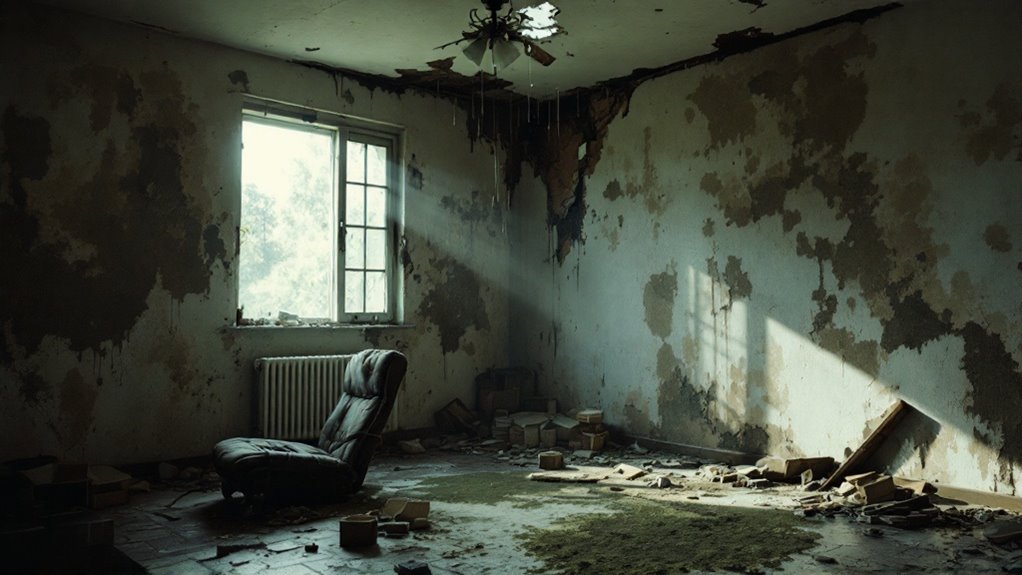It’s interesting how many homeowners underestimate the risks of staying in a water-damaged house. You might think it’s just a little moisture, but experts warn it can lead to serious health issues and structural damage. If you notice musty odors or sagging ceilings, it’s time to reconsider your safety. What should you do next? Understanding the dangers is essential to protecting yourself and your home.
Key Takeaways
- Staying in a water-damaged house poses risks like structural collapse, electrical hazards, and pest infestations that can threaten safety.
- Mold growth is a significant health concern; evacuate if you notice musty odors or visible mold.
- Assess visible damage such as sagging ceilings and cracked walls, as these indicate unsafe living conditions.
- Compromised electrical systems increase fire risks; professional evaluation is necessary before remaining in the home.
- Utilize local disaster relief services and community resources for immediate assistance if evacuation is required.
Understanding Water Damage: Types and Causes

When you encounter water damage in your home, it’s important to understand the various types and causes to assess the situation properly. Water damage typically falls into three categories: clean water, gray water, and black water. Clean water comes from sources like a broken pipe, while gray water, from appliances like dishwashers, contains some contaminants. Black water, the most dangerous, stems from sewage or flooding, posing serious health risks. Causes of water damage can vary, including heavy rainfall, plumbing issues, or roof leaks. Identifying the specific type and cause helps you determine the necessary steps for cleanup and repair. By understanding these factors, you can make well-considered choices about how to address the water damage effectively. Immediate response is crucial to mitigate long-term damage and ensure the safety of your home.
Immediate Risks of Staying in a Water-Damaged Home
Staying in a water-damaged home can pose significant immediate risks to your health and safety, especially if the damage is severe. Here are four essential risks to evaluate:
- Structural Damage: Weak walls and ceilings can collapse, endangering occupants.
- Electrical Hazards: Water can compromise electrical systems, increasing the risk of shocks and fires.
- Pest Infestations: Damp conditions attract pests like rodents and insects, which can carry diseases.
- Reduced Air Quality: Water damage can lead to air pollution from debris and contaminants, making it hard to breathe. Additionally, professional water damage restoration services can help mitigate these risks and restore your home to a safe condition.
If you find yourself in a water-damaged home, it’s vital to assess these risks and prioritize your safety. Think about relocating until repairs are complete to protect your health and well-being.
The Mold Factor: Health Risks and Prevention

How can you protect yourself from the hidden dangers of mold in a water-damaged home? First, be aware that mold thrives in damp environments, posing serious health risks like respiratory issues and allergic reactions. If you notice any signs of mold—like a musty smell or visible growth—act quickly. Remove affected materials, such as carpets and drywall, and ventilate the area to reduce moisture. Use a dehumidifier to maintain low humidity levels. When cleaning mold, wear protective gear like masks and gloves. If the problem is extensive, consider hiring a professional mold remediation service. Regularly inspect your home for leaks and fix any water damage promptly to prevent mold from returning. Comprehensive services are essential to ensure your health is worth the effort!
Assessing Structural Integrity After Water Damage
After experiencing water damage, it’s crucial to assess the structural integrity of your home to guarantee safety. Here’s how you can evaluate the situation:
- Check for Visible Damage: Look for sagging ceilings, cracked walls, or buckled floors that indicate structural issues.
- Inspect the Foundation: Examine the foundation for any cracks or shifting, as this can compromise stability.
- Assess Wood Structures: Look for signs of rotting or warping in wooden beams and supports, which can weaken the structure.
- Consult Professionals: If you’re uncertain, hire a structural engineer or contractor to conduct a thorough inspection and provide expert advice.
When to Evacuate: Signs You Should Leave

When should you consider leaving your water-damaged home? If you notice mold growth, it’s a clear sign to evacuate. Mold can trigger respiratory issues and other health problems, especially for vulnerable individuals. Furthermore, if you smell a strong musty odor or see water pooling in your living space, it’s time to go. Structural concerns, like sagging ceilings or walls, indicate potential collapse, posing a serious risk. If your home’s electrical system has been compromised, avoid staying until a professional assesses the situation. Finally, if you or anyone in your home experiences worsening health symptoms, such as headaches or breathing difficulties, don’t hesitate to leave. Your safety should always come first.
Professional Help: When to Call in the Experts
Wondering if it’s time to call in the experts? If you’re dealing with water damage, there are key situations that warrant professional assistance. Consider reaching out when:
- Mold Growth: You notice mold or mildew, which can pose serious health risks.
- Structural Damage: There’s visible damage to walls, floors, or ceilings that could compromise safety.
- Persistent Moisture: You can’t seem to dry out the area after a flood or leak.
- Health Symptoms: You or your family experience unexplained respiratory issues or allergies.
In these cases, professionals can assess the damage, provide specialized equipment, and guarantee your home is safe. Don’t hesitate to get help when you need it. Your health and safety come first!
Cleaning and Restoring: Steps to Take
To effectively clean and restore your home after water damage, it’s vital to act quickly and methodically. First, guarantee your safety by turning off electricity and wearing protective gear. Remove any standing water using pumps or wet vacs, then dry out the area with fans and dehumidifiers. Next, remove damaged materials like carpets, drywall, and insulation; these can harbor mold. Clean surfaces with a mixture of water and detergent, and disinfect them to eliminate bacteria. Once everything is dry, assess the structure for any hidden damage. Finally, monitor the area for signs of mold growth over the next few weeks. Taking these steps can help you return your home to a safe, livable condition.
Long-Term Effects of Water Damage on Your Home
Although immediate cleanup can mitigate some damage, the long-term effects of water damage on your home can be significant and often hidden. You might face issues that can worsen over time, including:
- Structural Weakness: Prolonged moisture can weaken beams and foundations.
- Mold Growth: Mold thrives in damp environments, leading to health risks.
- Pest Infestations: Water damage can attract pests like termites, which can further damage your home.
- Decreased Property Value: Unaddressed issues may lower your home’s market value, making it harder to sell.
If you notice any signs of water damage, addressing them quickly is critical to prevent more serious problems down the line. Your home’s safety and value depend on it!
Preventative Measures for Future Water Damage
While water damage can seem inevitable, there are several effective preventative measures you can take to safeguard your home. Start by regularly checking your roof for leaks and maintaining your gutters to guarantee proper drainage. Next, invest in sump pumps and water alarms to detect issues early. Finally, consider waterproofing your basement and making certain your home’s landscaping directs water away from the foundation.
Here’s a quick overview:
| Measure | Description | Frequency |
|---|---|---|
| Roof Inspection | Check for leaks and damage | Twice a year |
| Gutter Maintenance | Clean and clear debris | At least biannually |
| Sump Pump Testing | Verify functionality | Every 6 months |
Resources and Support for Affected Homeowners
If you’re facing the challenges of water damage in your home, knowing where to turn for help can make a significant difference. Here are some resources and support options you should consider:
- Local Disaster Relief Services – Reach out to organizations like the Red Cross for immediate assistance.
- Insurance Companies – Contact your insurer to understand your coverage options and file a claim.
- Professional Restoration Services – Hire experts who specialize in water damage to assess and restore your home safely.
- Community Support Groups – Join local forums or online groups to share experiences and get advice from others who’ve faced similar issues.
Utilizing these resources can help you navigate the recovery process more effectively and provide much-needed support during this challenging time.
Conclusion
In the face of water damage, your safety hangs in the balance. Ignoring the signs could lead to dire health consequences or worse. If you notice that musty smell or see sagging ceilings, don’t wait—act now. The longer you stay, the greater the risk to your well-being and home. Reach out to professionals who can assess and restore your space. Your health and safety should always come first. Will you take the necessary steps before it’s too late?
